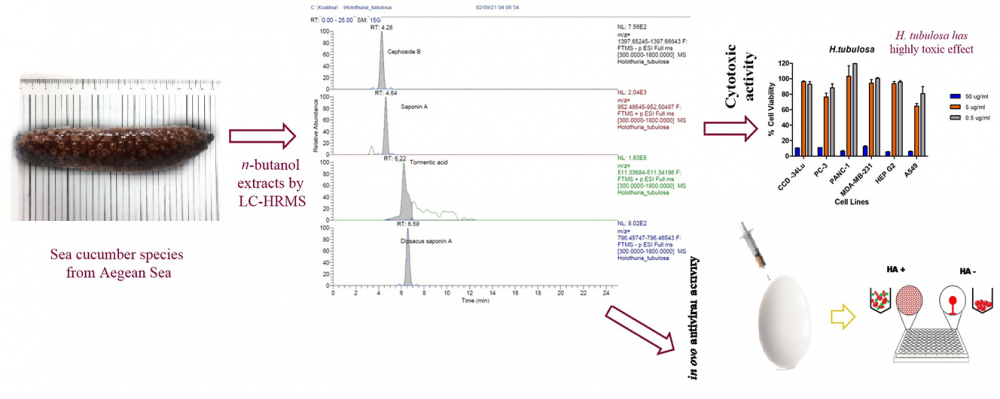JOURNAL 2349
Records of Natural Products
Year: 2022 Issue: 6 November-December
p.592 - 604
Viewed 3246 times.
GRAPHICAL ABSTRACT

ABSTRACT
There are nearly 1200 species of sea cucumber in the world's seas. Among these creatures included in the Holothuroidea class, 37 species show distribution in the Mediterranean and Aegean Sea. The purpose of this study is to determine the chemical content and biological potent of five sea cucumber species, Holothuria tubulosa, Holothuria poli, Holothuria mammata, Holothuria sanctori and Stichopus regalis, which were collected from the Aegean Sea. The detailed flavonoid, phenolic and triterpene contents were determined by LC-HR/MS. Cytotoxic activities against several cancer cell lines, MDA-MB-231, PC-3, A-549, PANC-1, HEPG2 and a healthy cell line CCD-34LU were performed by MTT method. Antiviral activities of the samples were measured as virucidal activity against avian coronavirus by in ovo. According to the results of LC-HRMS analysis, H. sanctori, H. poli and S.regalis had the richest chemical content diversity in terms of examined triterpene compounds. Fumaric acid was detected as the most abundant substance in all sea cucumber species. H. tubulosa had a highly toxic effect on all the tested cells. The best cytotoxic activity on A549 cells was seen in H. mammata, H. sanctori and H. poli. H. sanctori also showed a significant toxic effect against PANC-1, MDA-MB-231, HepG2 and A549 cells, whereas the IC50 value in CCD-34LU cells was above 50 μg/ml for this sample. The n-butanol extracts of sea cucumber species reduced hemagglutination (HA) virus titer between 1-fold to 4-fold in log2-based at all tested concentrations. The best inhibited virus HA titer results were found in H. tubulosa at 5 μg/g. According to these results we have obtained, the extracts of sea cucumbers may be used in many fields such as medicine, food, cosmetics in the future. This study is also very important in terms of being a guide for all studies on the use, processing and production of sea cucumbers and detailed isolation and purification studies on sea cucumber species from Turkey.
KEYWORDS- Holothuria
- Stichopus
- cytotoxicity
- antiviral activity
- LC-HRMS
- avian coronavirus